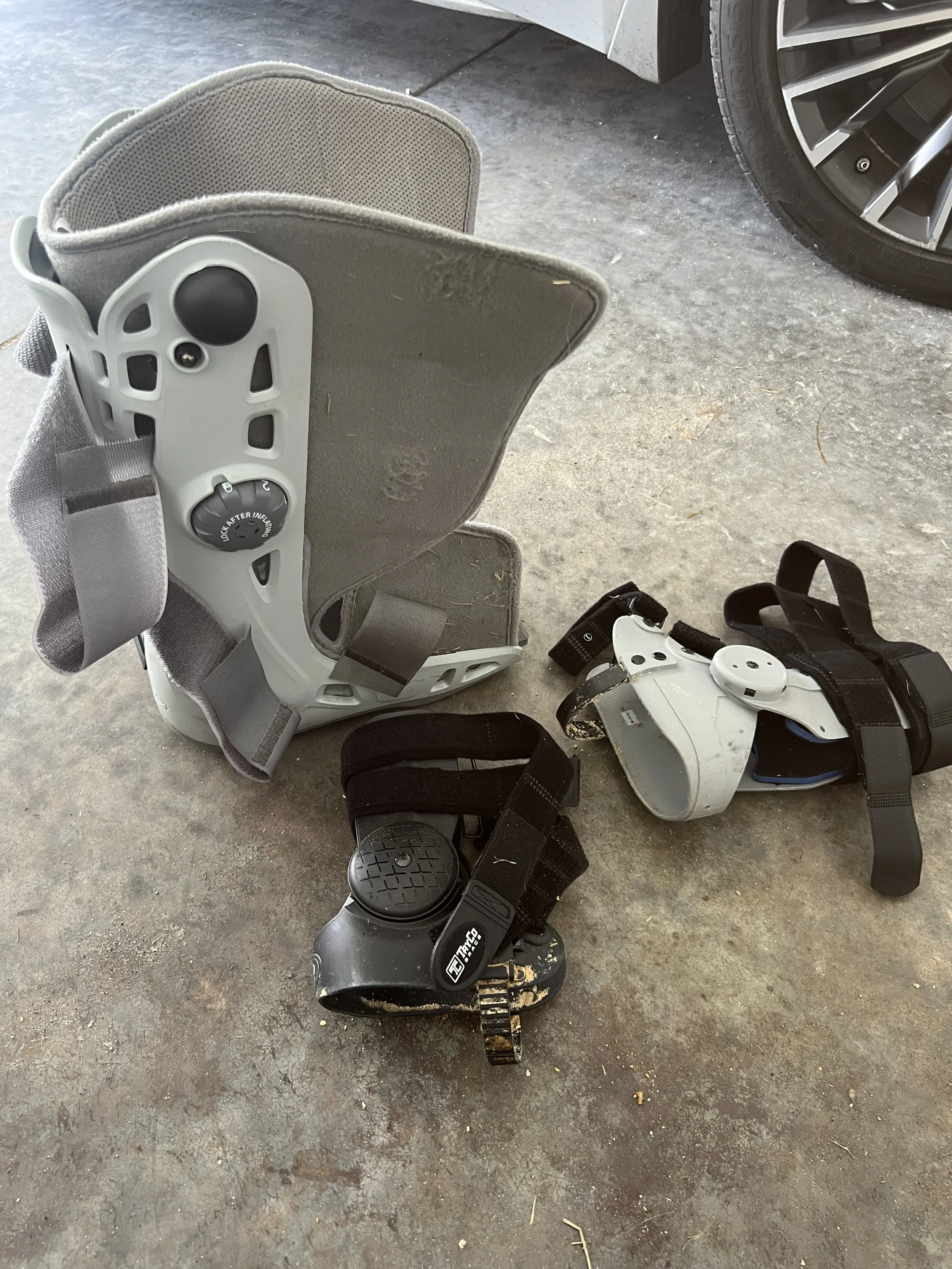Casts and Braces
Smart Protection
Recovering from an ankle fracture requires more than rest—it also depends on the right support devices. Casts, braces, and shoe-leveling tools protect your ankle, reduce pain, and help you transition back to normal movement. From the standard Aircast walking boot to advanced options like TayCo braces and practical accessories like the Level-Up shoe balancer, here’s a comprehensive guide to what you might use after an ankle fracture or surgery.
Disclaimer: This article is for informational purposes only and does not replace medical advice. Always consult your doctor about casts, boots and braces that are suitable for your injury.
Traditional Casts
Overview
Immediately following surgery, many patients are placed in a rigid cast. Casts are designed to immobilize the ankle completely, protecting surgical repairs and allowing bones, ligaments, and tendons to heal.
Pros
Maximum protection and immobilization
Prevents accidental movement that could disrupt healing
Commonly used in the initial recovery phase
Cons
Heavy and uncomfortable
Cannot be removed for bathing or sleeping
May contribute to stiffness and muscle weakness over time
Aircast Walking Boot
Overview
The Aircast walking boot is one of the most widely prescribed devices after ankle surgery. It features adjustable air bladders for customized compression and a rocker sole that promotes a more natural walking motion.
Pros
Provides stability while allowing limited mobility
Adjustable fit helps reduce swelling and pain
Removable for hygiene and sleeping (with doctor approval)
Cons
Bulky and heavy compared to braces
Can cause uneven walking without a balancing device
May still limit certain daily activities
Personal take: I removed the front plastic insert of the boot—per an online video from a doctor—when I was non-weightbearing on my knee scooter or iWALK crutch, as it rubbed my shin. This made it much more comfortable.
TayCo Braces
TayCo offers innovative external braces that attach directly to your shoe, providing support without the bulk of a walking boot. These braces have gained popularity among both patients and medical professionals for their versatility and effectiveness.
TayCo Recovery Brace
The TayCo Recovery Brace is designed as a functional alternative to the Aircast walking boot. Clinical studies have shown that it provides similar stability and protection compared to a traditional boot, while being lighter and easier to wear. It stabilizes the ankle externally, reducing strain on healing tissues while still allowing patients to maintain a more natural gait.
Pros
Comparable effectiveness to an Aircast in protecting the ankle
Lighter and less bulky than a walking boot
Attaches directly to the shoe for better balance and comfort
Easier to use for longer wear
Cons
Typically more expensive than standard boots
Not always available at every clinic or hospital
May require a supportive shoe for best results
Personal take: My surgeon didn’t approve this boot for me, prescribing a standard Aircast instead as it’s more protective and has a rocker sole. This meant my insurance wouldn’t cover it, setting me back about $180. It was worth every penny as the TayCo is light and allowed me to quickly begin long walks, which was crucial in my recovery. It also allowed me to drive, which was crucial to my mental health. The biggest con is that since you’re wearing a normal shoe, when your foot swells it becomes uncomfortable, so you might want to bring your Aircast along if you’ll be out a long time.
TayCo Easy-On Brace
The TayCo Easy-On Brace is tailored for later stages of recovery, when patients are transitioning from full support to lighter protection. It is designed to stabilize the ankle during daily activities while allowing greater freedom of movement than the Recovery Brace.
Pros
Ideal for the later recovery phase
Slimmer profile for easier wear with different shoes
Provides ongoing support without restricting mobility as much
Cons
Not intended for immediate post-surgery use
Provides less rigid support than the Recovery Brace or Aircast
The Even-Up Shoe Balancer
Overview
When wearing a cast, Aircast, or brace, one common issue is uneven walking. The injured leg is elevated, which throws off balance and puts stress on the hips, back, and knees. The Even-Up Shoe Balancer attaches to the sole of your good shoe to match the height of your recovery device.
Pros
Restores proper posture and balance
Reduces strain on hips, knees, and back
Easy to use with most shoes
Cons
Requires proper fit to avoid slipping
May feel bulky if worn for long periods
Choosing the Right Device
Most patients progress through several devices during recovery: a cast immediately after surgery, then an Aircast or TayCo Recovery Brace, followed by a lighter brace such as the TayCo Easy-On. Throughout this process, accessories like the Level-Up shoe balancer can make walking more comfortable and safer.
The right choice depends on your stage of healing, the type of ankle surgery performed, and your doctor’s recommendations.
Final Thoughts
Casts and braces are essential tools for ankle surgery recovery. A rigid cast provides initial protection, the Aircast walking boot allows controlled mobility, TayCo braces offer modern alternatives with strong clinical support, and the Level-Up device ensures balanced walking. By understanding each option’s purpose, pros, and cons, you can work with your healthcare team to select the best devices for your recovery journey.
Share Your Experience
Every recovery journey looks different. Did you use an Aircast, a TayCo brace, or another device that made your recovery easier? Have balancing tools like the Level-Up helped reduce strain on your hips and back?
Share your experience in the comments below. Your story may help someone else choose the right support device for their recovery.

